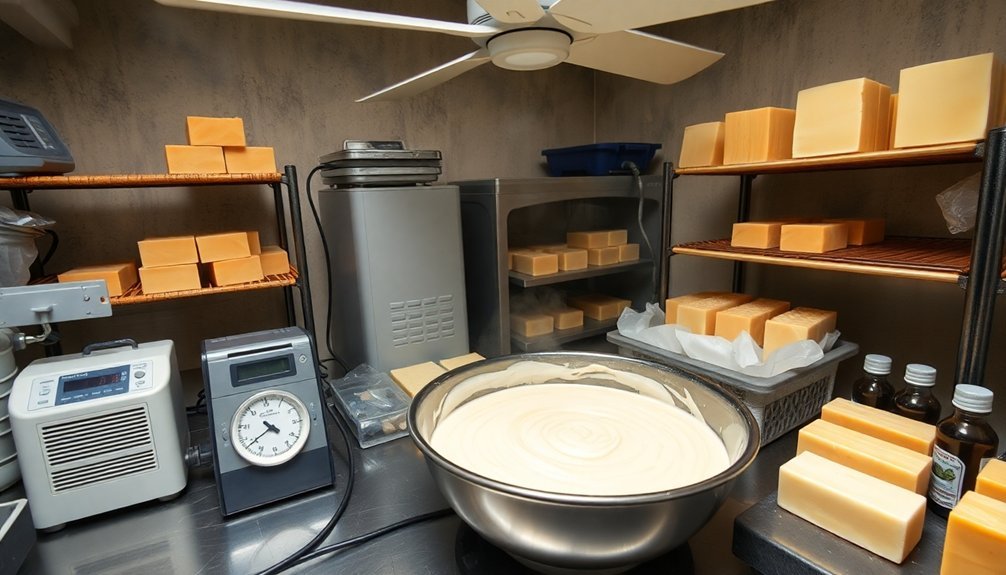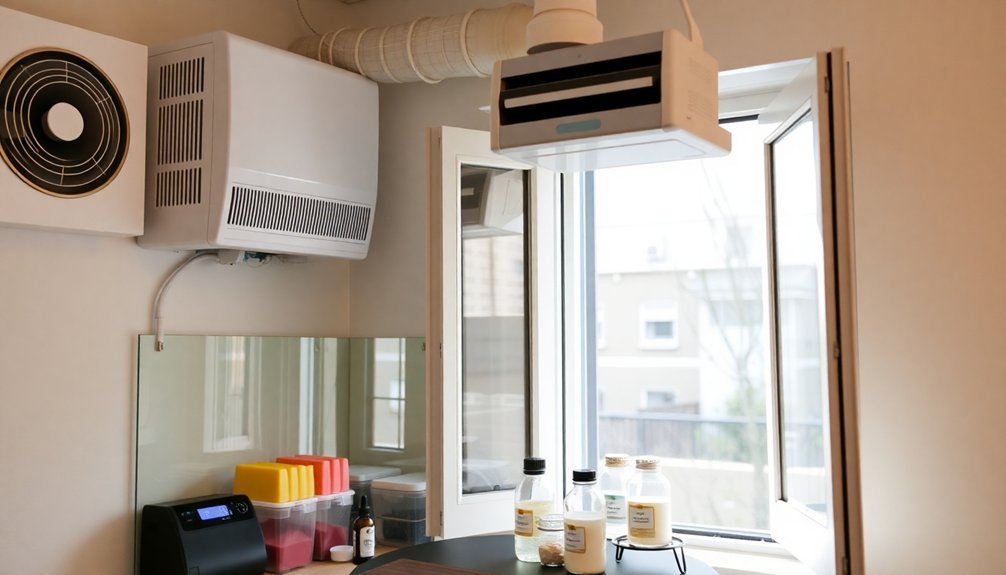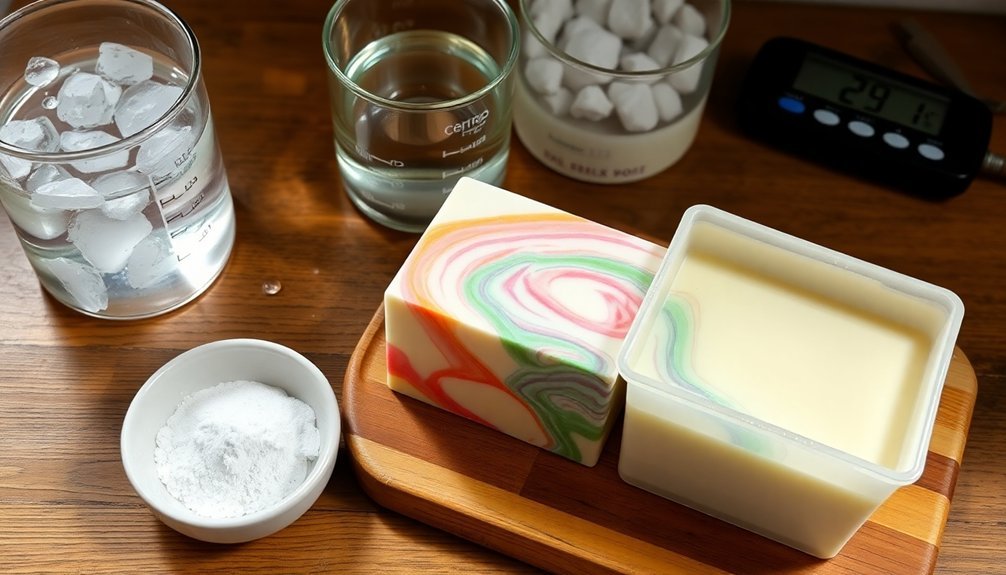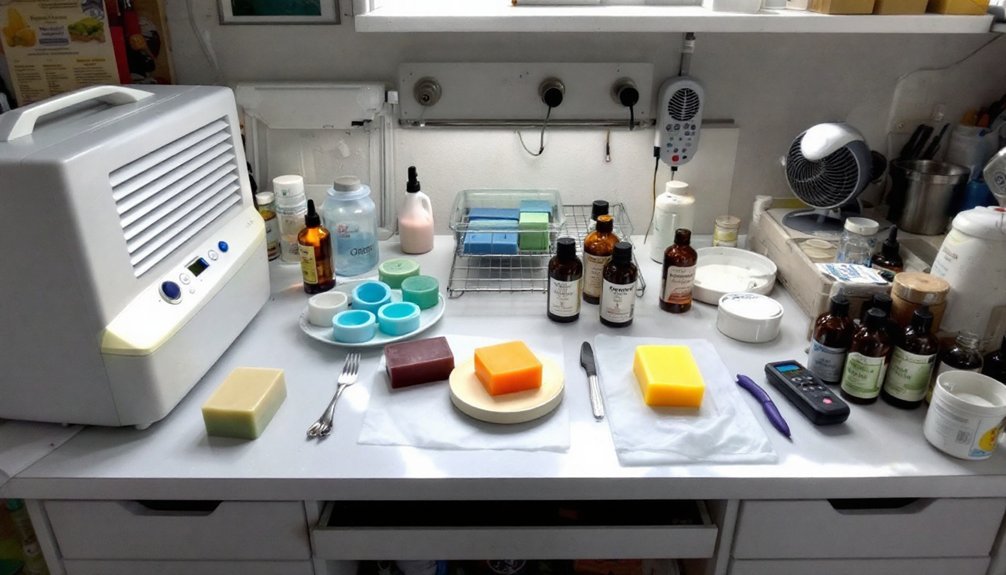For tricky soap making environments, adjust your water-to-lye ratio in humid conditions to prevent stickiness. Control temperatures by using warmer oils (110-130°F) in winter and cooler blends (90-100°F) during summer. Install exhaust fans where ventilation is limited. Slow trace acceleration by selecting olive oil over fast-moving alternatives. Add chelating agents like citric acid to combat hard water issues. These practical adaptations will transform your challenging space into a soapmaker's sanctuary.
Mastering Soap Making in High Humidity Conditions

When high humidity threatens to turn your soap-making endeavors into a sticky situation, understanding how to adapt becomes essential.
Adjust your formulation by reducing the water-to-lye ratio and selecting oils that remain solid at room temperature, like coconut and palm. Add clay or charcoal to absorb excess moisture, while limiting humectants such as glycerin, honey, and castor oil.
For curing, use dehumidifiers and maximize air circulation, but avoid dehydrators which can damage your bars. Monitor curing progress by weighing soaps periodically. The saponification process continues during curing, transforming your mixture into true soap.
Protect finished products with appropriate packaging—consider shrink wrap, waxed paper, or cellophane depending on your priorities.
Prevent sweating by storing soaps in airtight containers with silica beads and maintaining a cool, dry workspace. Arrange bars vertically on shelves to minimize moisture exposure.
Temperature Control Strategies for Extreme Weather
As weather extremes present unique challenges for soap makers, mastering temperature control becomes essential for consistent results.
Whether you're battling freezing temperatures or sweltering heat, adjusting your soaping techniques can prevent common issues like false trace or overheating.
- Adjust starting temperatures – Use warmer oil/lye temperatures (110-130°F) in cold weather and cooler temperatures (90-100°F) during hot conditions.
- Modify your insulation – Insulate more during winter, less (or not at all) during summer months.
- Choose appropriate oils – Select lower melting point oils during cold weather to prevent false trace.
- Manage additives carefully – Heat-sensitive ingredients like milk or honey require cooler processing temperatures.
- Control your workspace – Use fans, air conditioning, or heating as needed to stabilize your environment.
Consider CPOP (Cold Process Oven Processing) at 140°F when dealing with unpredictable room temperatures, as this method can provide consistent saponification regardless of seasonal changes.
Adapting Your Workspace for Limited Ventilation

Limited ventilation presents a significant challenge for soap makers, beyond the temperature control issues we've discussed. You'll need to implement targeted solutions to protect yourself and guarantee product quality. Equip your space with exhaust systems and HEPA filters to remove harmful fumes and particulates. Split system HVAC units work exceptionally well in small soap shops where space constraints are a concern.
| Equipment | Purpose | Best For | Installation Tip |
|---|---|---|---|
| Exhaust Fans | Remove fumes | Lye mixing areas | Direct airflow away from work zones |
| HEPA Filters | Purify air | Dusty environments | Change filters regularly |
| Respirators | Personal protection | Chemical handling | Guarantee proper fit testing |
| Ventilated Trays | Improve soap curing | Limited spaces | Stack vertically to maximize airflow |
Optimize your layout by reducing clutter and creating dedicated zones for chemical handling. When working with lye, always wear appropriate respiratory protection with organic vapor cartridges and maintain clear emergency procedures.
Managing Trace Acceleration in Hot Climates
Soap makers in hot climates face a frustrating challenge: accelerated trace that can derail even carefully planned designs.
When temperatures rise, your soap batter thickens faster, limiting design time and potentially causing uneven textures in your final bars.
To combat this common issue:
- Cool your workspace with air conditioning or fans to slow the saponification process
- Select slow-moving oils like olive oil rather than accelerants like coconut oil
- Lower your lye and oil temperatures (around 100°F) to extend workability time
- Use more water in your recipe to delay trace, though this affects cure time
- Blend minimally with short bursts of your stick blender rather than continuous mixing
These adjustments will help you maintain control over your soap batter even when the mercury rises. Understanding that recipes containing predominantly liquid oils allow for more temperature flexibility will help you formulate more heat-resistant soap batters.
Creating Perfect Soap Despite Hard Water Issues

Hard water can sabotage even the most carefully crafted soap recipes, leaving your beautiful creations plagued with reduced lather and frustrating soap scum.
The calcium and magnesium minerals in hard water react with soap molecules, creating that telltale white residue and diminishing performance.
Combat these challenges by adding chelating agents to your formulations. Use citric acid (1-3% of oil weight) or tetrasodium EDTA (0.5%) to bind those troublesome minerals.
Boost your coconut oil percentage for better lather, and consider reducing your superfat slightly. Increasing coconut oil to at least 30% will significantly improve your soap's ability to lather in mineral-rich water.
For your customers, recommend vinegar rinses to tackle existing soap scum and explain proper usage techniques.
You can also create a hard water test bar using pure Castile soap—if it forms cloudy water instead of clear suds, you're dealing with mineral-rich water.
Frequently Asked Questions
How Do Essential Oils Affect Trace Compared to Fragrance Oils?
Essential oils are variable, potentially accelerating or slowing trace due to their natural composition. You'll find fragrance oils more consistent and predictable, making them easier to work with during soap making than their natural counterparts.
Can I Safely Substitute Sodium Hydroxide With Potassium Hydroxide?
No, you can't safely substitute NaOH with KOH without adjusting your recipe. They create different soap types—NaOH makes solid bars while KOH produces liquid soap. The substitution would completely change your product's consistency.
What Causes Tunneling and Air Pockets in Soap?
Tunneling in your soap often results from overheating or insufficient mixing, while air pockets typically come from over-blending or faulty blender seals. You'll prevent both by controlling temperatures and refining your pouring techniques.
How Does Altitude Impact Soap Curing Times?
At higher altitudes, you'll notice shorter soap curing times due to lower humidity that accelerates water evaporation. You can take advantage of this by using less water in your initial recipe for faster results.
Why Does My Colorant Morph or Fade After Curing?
Your colorant morphs or fades because of UV exposure, chemical interactions with fragrances, pH sensitivity, or environmental factors. Try storing soap away from light, testing colorants beforehand, and using stabilizers to preserve vibrant colors.
In Summary
Don't let environmental challenges discourage your soap making journey. You've now got five practical solutions to overcome humidity, temperature extremes, poor ventilation, accelerated trace, and hard water issues. With these adjustments to your technique and workspace, you'll create beautiful, consistent soaps regardless of your conditions. Remember, successful soap making isn't about perfect environments—it's about adapting skillfully to the environment you have.





Leave a Reply